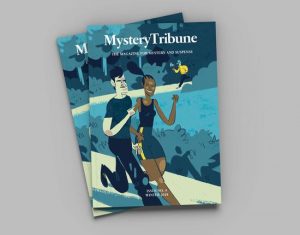 Mystery Tribune Issue No. 4
Mystery Tribune Issue No. 4
Winter 2018
The Magazine for Mystery and Suspense
236 pages
Edited by Ehsan Ehsani
The first story in the Winter 2018 issue of Mystery Tribune, "A Friend Indeed" by Brendan DuBois, effectively sets a tone.The discursive narrator, software designer Caleb Willis, tells us everything we need to know in the first long sentence of the story: "So after my second mistrial and my final release from county prison, I decided to take up walking, since there's not much to do with my life after I had been accused of murdering my best friend, who also happened to be sleeping with my wife, while also in the process of stealing my company." After a little backtracking, the story unfolds neatly, following that old dictum: the journey's the thing, not the destination.
The second story, "The Current," by Dan J. Fiore, features one of the best descriptions I've ever seen of being accidentally drunk, the details coming through loudly and in in near-hallucinatory detail. "It feels like there's a wall in Shawn's mind, a brick wall just behind him blocking out everything that came before. Thinking, remembering–it's like banging against the bricks and the wall moves and shakes and bends and bits get through but not enough to see. Not enough to understand." Poor Shawn, a nine-year-old kid, is drunk, found by a father who's inconsistent and a liar at best and retrograde asshole at his worst. Bad shit ensues, but as the story closes, Shawn "knows that hidden under it all, beyond the darkness and chaos, is a place where it's calm and quiet and finally still." This is a story I didn't expect to like as much as I did in the end.
"Kill One, Get One Free," by David Rachels takes an old saw, the gangster making his bones, and injects some mean lines and life into it. "This was the first moment I understood what I was signing up for–what I had already signed up for. It was kill or be killed. At once, killing this old lady seemed like an act of self-defense. I felt my conscience relax." This brings us into the mindset of our almost-hitman, but there's still a turn to come, and it's a good one. It also features my favorite ending of the stories I read in this issue, a conclusion both satisfying for the story and intriguing enough to want to read more about this character. Plus, you hear writers quote someone famous about the power of the appropriately placed period; this story's only exclamation point does the same thing, but better.
Todd Scott's "Wolf bite" is the third story to feature a dog prominently. This particular beast is one to remember. "It comes at him fast from the other side of the trailer. Low to the ground, throwing dust and rocks. Head as big as a fucking mailbox. Maybe a dishwasher, with a whole dinner setting worth of teeth, shined up bright. It's a fucking shark on brindle legs. Barking its goddamn head off." This is Tommy Dale Keegan's dog, both dog and owner bad actors, and the Midland Police Department, in the person of Ben Harper, has to shoot one of them. The first line tells the story: Ben Harper doesn't shoot the dog, even after he gets bitten. This is a really fine piece, discussing both man and dog, and man and woman, the two strains tied together skillfully and irresistibly. Plus, I'm a sucker for s good dog story.
A story of another kind entirely, "Death In Florence" by Nick Kolakowski brought me to a place I've never been and planted me squarely on terra firma. "Despite the constant threat of vehicular slaughter, I love this place: the tall sidewalks lined with candy-colored mopeds, the imposing wooden doors plastered with flaking posters, the cries of ambulances and sparrows, the Senegalese dealing postcards and cheap trinkets from cardboard stands (all the better to fold away when the Carabinieri make an appearance)." The rest of this well-structured story details a woman on a quest that isn't all it seems to be, with a twist I didn't see coming at all. The best kind of story, this one demanded a reread immediately to find the clues the author left behind.
"Oil Down," too, relies on setting to convey its power, particularly in writer Brian Silverman's descriptions of or mentions of food. The mentions range from roti to Carib beer to Stallion overproof rum, but in particular, oil down, "a one pot stew featuring salted meats, greens, provisions like breadfruit or cassava and cooked slowly in coconut oil and coconut milk often served at Sunday dinner" all of which sets a scene as capably as any more typical description of landscape or people. The story itself involves the death of a vagrant, called Filthy Man, and the efforts of a local bar owner, Len Buonfiglio, a refugee from New York, to solve the possible murder with the assistance of several locals. This piece has the feel of a novel about it, and one hopes we'll see more of Mr. Len's story somewhere else.
"Dad" by Hugh Fraser closes out the fiction in this issue. A short vignette about the narrator's troubled relationship with his father, this piece deals more with the aftermath of a crime than the committing of one, and seems a more subtle tack to take in the midst of the other more traditional narratives in the issue. The story opens as the narrator remembers his life with his father. "At least the waiter has only one taste of his garbage, he has no idea what it was like to live with it for thirty seven years. Every goddam thing he ever said to me, since I can remember, was some way of making himself feel good at my expense." Needless to say, this isn't going to end well for anyone involved.
Fiction is obviously the main attraction for me, but beside the stories, there's a Q&A with Rick Geary, revealing interviews with Tom Sweterlisch, Nick Petrie and Sean Phillips, and a review of James Anderson's Lullaby Road. Plus, there's an article by Elena Avanzas Alvarez called "Psychopaths in Crime Fiction." I don't know enough about photography to comment deeply, but photographers Malgorzata Sajur and Ashley Joncas held and rewarded my interest. The added bonus of photo illustrations for each story is a great thing I wish more journals could afford to do.
Overall, this is a strong issue of Mystery Tribune, a magazine I'll return to in the future. You can subscribe for $48 yearly (four issues) or buy single copies at www.mysterytribune.com, and you should if you're interested in contemporary crime fiction.





